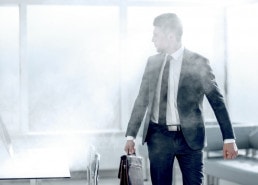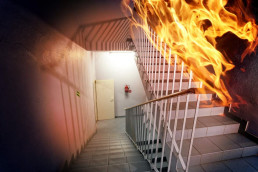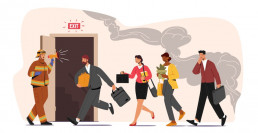Each year, around 400 people in Germany die as a result of a fire. When a fire breaks out, it burns uncontrollably and panic quickly ensues. What should you do in the event of a fire? What are the hazards of fire and how can a fire be avoided? We answer these questions in the following blog post. Have you already implemented all of the necessary fire protection measures in your company?
The hazards of fire
It is not the flames themselves that are the most frequent cause of death in a fire, but rather the fumes that are produced – 95% of fire victims suffocate in the toxic smoke. Smoke development is the biggest hazard in the event of a fire. If a rubbish bin containing 10 kg of paper or cardboard sets on fire, for example, it will release up to 10,000 m3 of gas. With the same quantity of foam rubber, around 20,000 m3 of fumes will be produced. Within seconds, the toxic fumes disperse throughout the entire room blocking the view of any people still inside. This makes it almost impossible to escape the blaze – and the carbon monoxide gases that are produced also cause a sharp drop in concentration. The longer the blaze burns, the more gases are produced – these initially cause headache and, after longer exposure, result in smoke poisoning and ultimately a loss of consciousness, which in the worst case leads to death.
Depending on the source of the fire, the fumes will contain different substances, which are harmful to the lungs and the body – in addition to carbon monoxide, these can include hydrochloric acid, sulphur dioxide, ammonia gas, phosgene or cyanide compounds. The toxic substances enter the lungs causing burns to the inner surface of the lungs, swelling of the trachea or preventing the blood from transporting oxygen. When this kind of inhalation trauma occurs, oxygen intake is made more difficult and can even be impossible. The chance of survival after inhalation of toxic substances is therefore very low. That being said, around 6,000 people do survive fires each year, with long-term damage. This usually concerns the lungs or combustion residues on the skin, which cause pain or affect the person in another way.

That’s because, alongside the fumes, the hazard of the flames must not be underestimated. Few people die due to skin burns, but such burns are extremely painful and can be fatal not only in combination with smoke poisoning. Skin burns are classified according to severity, with the degree of burn and the proportion of burnt area being determined.
Degrees of burn
First degree: Reddening and slight swelling of the skin, pain – reversible
Second degree: Blistering with red-white base, significant pain – heals fully or with scarring
Third degree: black-white blisters/necroses, no to low pain, as the nerve endings are destroyed – irreversible
Fourth degree: Charring, no pain, all layers of the skin and the underlying bone are affected – irreversible
Proportion of burnt area
Head/neck: 9%
Trunk: 36% (4×9)
Arms: 18% (2×9)
Legs: 36% (2x2x9)
Genitals: 1%
If more than 10% of the body surface suffers second to third degree burns, this is life-threatening and can trigger hypovolaemic shock. Whether or not the person survives this shock is dependent on their general state of health and their age.
Fire protection in the company
To prevent fires in the company, all potential hazards that could cause a fire should be determined with the help of a risk assessment. The most frequent cause of fires is electricity. 32% of all fires are caused by misfires in electrical systems and devices. Of the 3,500 or so fires that are reported each year to the employer’s liability insurance association, 17% are due to human error. Alongside overheating, arson, work involving a fire hazard and lightning strikes, there are a further 21% of fires for which no cause can be determined.

To prevent a fire from breaking out and ensure adequate protection for yourself and your company, two points are particularly important: Fire prevention and fire protection measures.
With fire prevention, you take structural fire protection measures in advance, which, on the one hand, can prevent fires from occurring and, on the other hand, ensure that a fire cannot spread very far and progress through the entire building. You should use construction materials that are not easily flammable. You can find out how flammable these materials are by looking at the construction material class – also called the fire protection class. These are classified according to the European standard DIN EN 13501-1 and the national standard DIN 4102-1.
National classification as per DIN 4102-1
- A1 = non-combustible, do not contain any combustible components, no smoke development or flaming droplets – e.g. cement, reinforced concrete, glass, brick, mortar, sand, mineral fibres
- A2 = non-combustible, certain proportion of combustible components, no smoke development or flaming droplets – e.g. plasterboards with sealed surface
- B1 = not easily flammable, does not continue to burn after removal from the ignition source – e.g. plasterboard with perforated surface, HWL panels, heat insulation plaster system as per DIN 18550-3
- B2 = flammable, ease of ignition remains limited to the size specified in DIN 4102-1 in the case of edge or surface flammability with a small flame – e.g. U-PVC pipes & moulded parts, wood & engineered wood with gross density ≤ 400 kg/m3 and thicker than 2 mm, plasterboard composite panels
- B3 = easily flammable, may only be installed in buildings if combined with other construction materials in such a way that they are no longer easily flammable – e.g. paper, foam plastic, straw
European classification as per DIN EN 13501-1
- A = non-combustible
- B = very limited combustibility
- C = limited combustibility
- D = acceptable contribution to fire
- E = tolerable fire behaviour
- F = no performance observed
- s1 = low smoke development
- s2 = medium smoke development
- s3 = high smoke development
- d0 = no flaming droplets within 600 seconds
- d1 = no flaming droplets with a continued combustion time of more than 10 seconds within 600 seconds
- d2 = no performance observed
Fire protection measures organised in advance should minimise the overall damage in the event of a fire. That’s because, in most cases, the collateral damage of the fire-fighting operations is greater than the damage caused by the fire itself. The biggest fires in recent years caused damage amounting to EUR 711 million.
In addition to structural precautions, you should also define organisational fire protection measures in your company. You must define rules for easily combustible areas and measures that should be taken to rescue employees. One of the most important measures is to provide fire extinguishers: Ensure that these are positioned throughout the building in clearly visible locations, at a height of max. 80–120 cm, so that anyone can reach them. Mark the locations of the fire extinguishers in the escape and rescue plan, so that they can be found quickly in an emergency. Also ensure that the fire extinguishers are regularly inspected and maintained. Sufficient fire protection assistants and a fire protection officer must be appointed in advance and given adequate training. It is your fire protection officer’s job to organise the fire protection measures in your company and to monitor whether or not these are being correctly adhered to and observed by the employees. They must be given regular training on what to do in the event of a fire and, ideally, practise this during fire drills. The fire protection officer is responsible for defining and documenting the code of conduct in the event of a fire, so that fire safety can be proven to the employer’s liability insurance association during a site inspection.

What to do in the event of a fire
What should you do if a fire breaks out in your company despite exemplary fire protection measures? The most important thing: Stay calm and don’t panic! Move yourself and your employees to a safe place as quickly as possible. To escape the toxic fumes produced by the fire in good time, you need to leave the room in which the fire is burning within 3 minutes. Unfortunately, many people concerned assume that they have enough time to escape and only register the hazard of smoke development when it is already too late. It only takes a few minutes for the fumes to block all escape routes and exits, so that it is almost impossible to get through. If you do not manage to get out on time and too much smoke has already developed around you, you can potentially protect yourself against the heat and smoke by assuming a bent-over position – at a push, you could crawl out of the danger zone, because smoke and heat rise at first.
Only once you have left the area surrounding the fire source, call the fire brigade – 112. It is important to tell the fire brigade the following information: What has happened? Where did it happen? Has anybody been injured?
After you have called for help, you must make sure that everyone in the building is aware of the fire and is already seeking safety. Check the break rooms too! If you are still able, switch off all electrical systems and close the main gas supply cock to prevent explosions.
As a fire protection assistant, you should assess the situation correctly to see if it is possible to contain the fire with fire extinguishers. If this is not the case, you too should move to safety as quickly as possible and observe the defined code of conduct.
How is fire protection organised in your company? Tell us about your fire protection measures and code of conduct, so that other companies can also be inspired and protect themselves effectively against fires. Of course, uvex also provides appropriate personal protective clothing, which will protect you and your employees against heat and flames. Contact us for more information.